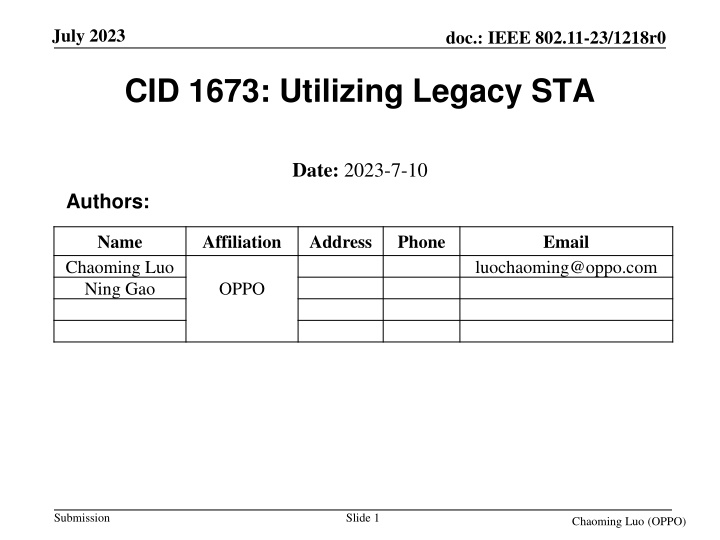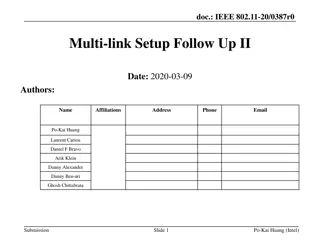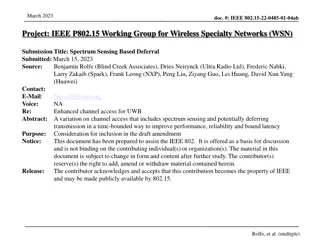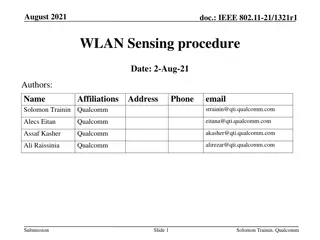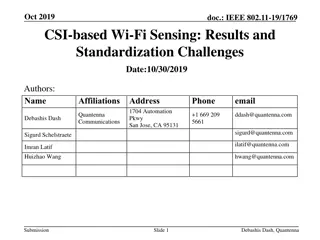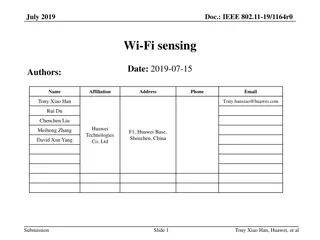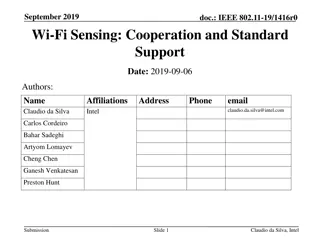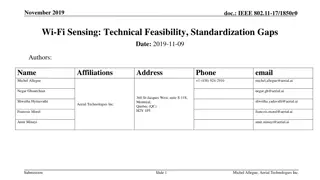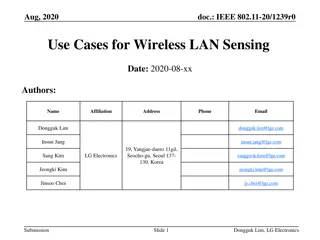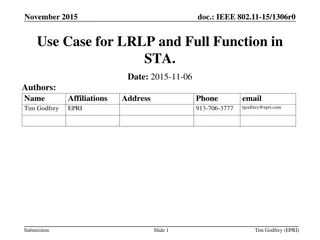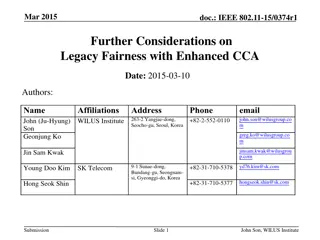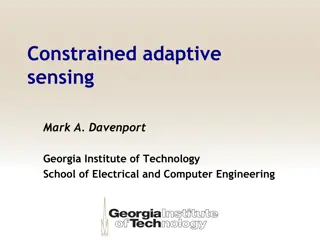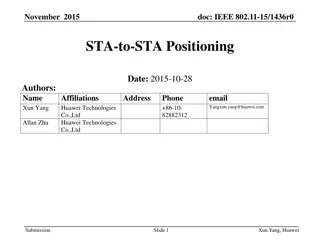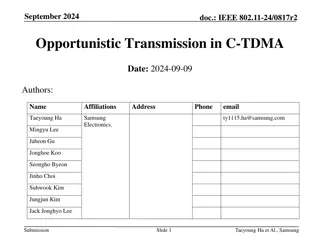Utilizing Legacy STA in Opportunistic Sensing
This contribution proposes a solution to CID 1673 in the IEEE 802.11-23 standard, focusing on utilizing legacy HE STAs in opportunistic sensing scenarios to enhance sensing capabilities. The document discusses the motivation, scenario, and simple changes required for incorporating opportunistic sensing as a complementary methodology, aiming to improve sensing results in heterogeneous network deployments.
Download Presentation

Please find below an Image/Link to download the presentation.
The content on the website is provided AS IS for your information and personal use only. It may not be sold, licensed, or shared on other websites without obtaining consent from the author.If you encounter any issues during the download, it is possible that the publisher has removed the file from their server.
You are allowed to download the files provided on this website for personal or commercial use, subject to the condition that they are used lawfully. All files are the property of their respective owners.
The content on the website is provided AS IS for your information and personal use only. It may not be sold, licensed, or shared on other websites without obtaining consent from the author.
E N D
Presentation Transcript
July 2023 doc.: IEEE 802.11-23/1218r0 CID 1673: Utilizing Legacy STA Date: 2023-7-10 Authors: Name Affiliation Address Phone Email Chaoming Luo Ning Gao luochaoming@oppo.com OPPO Submission Slide 1 Chaoming Luo (OPPO)
July 2023 doc.: IEEE 802.11-23/1218r0 Introduction This contribution proposes a solution to CID 1673. PDT doc will be submitted later. CID Commenter Page Comment Proposed Change Add one bit in SBP request to indicate using of opportunistic sensing, and add corresponding procedure. 1673 Chaoming Luo191.06 Add support for using opportunistic sensing by SBP to utilize legacy STAs. Submission Slide 2 Chaoming Luo (OPPO)
July 2023 doc.: IEEE 802.11-23/1218r0 Scenario The reality of the early stage of 11bf: o There are good number of 11ax clients (i.e., legacy STAs) in the existing deployments (houses, offices, malls, etc.) o Will new 11bf clients be popular in those deployments in a short time? Probably NO! It takes time. A user would have one 11bf AP and one or two 11bf phone/pad, which is a typical and realistic deployment in the early stage of 11bf. As stated in [1], in 2023 the market share of 11ax devices is dominant. A few 11bf devices A good number of legacy HE devices Submission Slide 3 Chaoming Luo (OPPO)
July 2023 doc.: IEEE 802.11-23/1218r0 Motivation Utilizing legacy HE STAs in sensing would be beneficial in the marketing of sensing. o Is it enough for a user to have a pretty good sensing result using TB measurement in a deployment as shown in slide 3? May be NOT! It is limited in TX/RX diversity and area coverage due to limited number of 11bf STAs. o Utilizing legacy STAs in such a deployment could be complementary to the current TB/SBP sensing. [2] introduces the concept of opportunistic sensing on regular PPDUs. [3] uses opportunistic sensing with changes required in legacy STA. Submission Slide 4 Chaoming Luo (OPPO)
July 2023 Opportunistic sensing as a complementary way TB measurement exchange(s) Report is outside of AVW, or delay to the next AVW doc.: IEEE 802.11-23/1218r0 Opportunistic sensing by AP, SBP Report SBP Report AP SBP responder STA1 SBP Initiator STA2 Sensing Responder Regular UL PPDU STA3 Legacy HE STA Regular UL PPDU STA4 Legacy HE STA availability window assigned for SBP Submission Slide 5 Chaoming Luo (OPPO)
July 2023 doc.: IEEE 802.11-23/1218r0 Simple Changes Is it complex to optionally support the opportunistic sensing as a complementary way? No, it s simple and with very few changes. o Some of the existing APs already support opportunistic sensing in a proprietary manner. o To be complementary to TB measurement, an AP just needs to do measurements on regular UL PPDUs from legacy HE STAs and indicates the CSI to its SME via the MLME primitive. o To be complementary to TB measurement initiated by SBP procedure, SBP initiator use one bit opportunistic in SBP request to ask the SBP responder to do TB measurements with 11bf STAs AND do measurements on regular UL PPDUs from legacy HE STAs. Submission Slide 6 Chaoming Luo (OPPO)
July 2023 doc.: IEEE 802.11-23/1218r0 Q&A It may be possible to let AP also obtain CSI on regular UL PPDUs from sensing responders in order to get a higher frequency of report than the current TB measurement. o Fine to add it. Privacy may be a concern. o Privacy talks about data/frames carrying information related to a user. In the case of sensing receiver, the CSI data is generated by the sensing receiver, and he does not want another STA to use this CSI data owned by this sensing receiver. It may make sense because I decide how should my data be used . o However, in the case of sensing transmitter non-AP STA (or the legacy HE STAs in opportunistic sensing), the CSI data is generated by the AP, it should be the AP to decide how its data be used. o BTW, keep in mind that an attacker can generate CSI upon receiving any PPDU carrying a Data frame. If this causes privacy issue, then all kinds of wireless communication systems (Wi-Fi, BLE, cellular, etc.) should be abandoned! Submission Slide 7 Chaoming Luo (OPPO)
July 2023 doc.: IEEE 802.11-23/1218r0 Q&A HT/VHT PPDUs use different LTF and carrier spacing, so the numerical values of CSI varies. HE PPDUs use 2xLTF, which requires no change of CSI structure. o Fine to limit to legacy HE STAs. How much value this complementary opportunistic sensing adds to the TB sensing? o It s complementary and shall be used together with TB sensing. The sensing application should still rely on the TB measurements results and use the complementary CSIs to improve accuracy. o Cases a legacy HE STA happens to send regular UL PPDUs continuously and not change transmitting parameters much o The AP could intentionally schedule a legacy HE STA to transmit UL PPDUs using fixed transmitting parameters. o There are bunch of papers using experimental setups such as: let the transmitting STA sends continuous UL PPDUs carrying Data frames of ICMP packets. Submission Slide 8 Chaoming Luo (OPPO)
July 2023 doc.: IEEE 802.11-23/1218r0 Summary Propose to add opportunistic sensing as a complementary way to the TB and SBP procedure. Local sensing application in an AP may ask the AP to obtain CSI on regular UL HE PPDUs from sensing responders and/or legacy HE STAs. Add one bit in SBP Request frame to ask the SBP responder to obtain CSI on regular UL HE PPDUs from sensing responders and/or other associated legacy HE STAs. The corresponding SBP report may be delivered outside of the AVW or delay to the next AVW. Note1: To keep the report structure and the numerical the same, AP may only include CSI of UL when it schedules UL transmission using 2xLTF having the same Ng, etc. Note2: this requires no change in legacy HE STAs. Submission Slide 9 Chaoming Luo (OPPO)
July 2023 doc.: IEEE 802.11-23/1218r0 Reference [1] 11-23-0284-00-0uhr-beacon-design [2] 11-21-1581-01-00bf-opportunistic-sensing-measurements [3] 11-21-1745-02-00bf-opportunistic-wlan-sensing Submission Slide 10 Chaoming Luo (OPPO)
